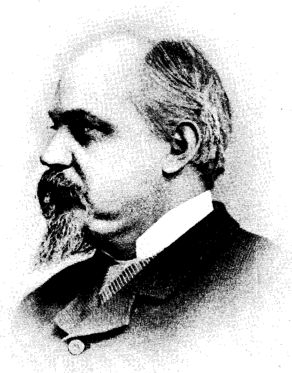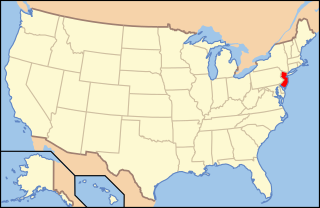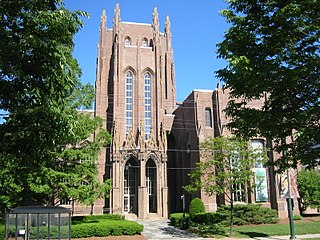Zoology is the scientific study of animals. Its studies include the structure, embryology, classification, habits, and distribution of all animals, both living and extinct, and how they interact with their ecosystems. Zoology is one of the primary branches of biology. The term is derived from Ancient Greek ζῷον, zōion ('animal'), and λόγος, logos.
Charles Gald Sibley was an American ornithologist and molecular biologist. He had an immense influence on the scientific classification of birds, and the work that Sibley initiated has substantially altered our understanding of the evolutionary history of modern birds.

John Bell Hatcher was an American paleontologist and fossil hunter known as the "king of collectors" and best known for discovering Torosaurus and Triceratops, two genera of dinosaurs described by Othniel Charles Marsh. He was part of a new, professional middle class in American science, having financed his education with his labor while also being more educated than older fossil collectors. As such, he faced unique challenges throughout his long and productive career.

Othniel Charles Marsh was an American professor of paleontology at Yale College and president of the National Academy of Sciences. He was one of the preeminent scientists in the field of paleontology. Among his legacies are the discovery or description of dozens of new species and theories on the origins of birds.

Edward Drinker Cope was an American zoologist, paleontologist, comparative anatomist, herpetologist, and ichthyologist. Born to a wealthy Quaker family, he distinguished himself as a child prodigy interested in science, publishing his first scientific paper at the age of 19. Though his father tried to raise Cope as a gentleman farmer, he eventually acquiesced to his son's scientific aspirations.

John Harold Ostrom was an American paleontologist who revolutionized the modern understanding of dinosaurs. Ostrom's work inspired what his pupil Robert T. Bakker has termed a "dinosaur renaissance".

Alpheus Hyatt was an American zoologist and palaeontologist.

Addison Emery Verrill was an American invertebrate zoologist, museum curator and university professor.
Hubert Lyman Clark was an American zoologist. The son of Professor William Smith Clark, he was born at Amherst, Massachusetts, and educated at Amherst College and Johns Hopkins University.
Harry Blackmore Whittington FRS was a British palaeontologist who made a major contribution to the study of fossils of the Burgess Shale and other Cambrian fauna. His works are largely responsible for the concept of Cambrian explosion, whereby modern animal body plans are explained to originate during a short span of geological period. With initial work on trilobites, his discoveries revealed that these arthropods were the most diversified of all invertebrates during the Cambrian Period. He was responsible for setting the standard for naming and describing the delicate fossils preserved in Konservat-Lagerstätten.

Richard Swann Lull was an American paleontologist and Sterling Professor at Yale University who is largely remembered now for championing a non-Darwinian view of evolution, whereby mutation(s) could unlock presumed "genetic drives" that, over time, would lead populations to increasingly extreme phenotypes.
Invertebrate zoology is the subdiscipline of zoology that consists of the study of invertebrates, animals without a backbone.
Jacques Armand Gauthier is an American vertebrate paleontologist, comparative morphologist, and systematist, and one of the founders of the use of cladistics in biology.
Charles Schuchert was an American invertebrate paleontologist who was a leader in the development of paleogeography, the study of the distribution of lands and seas in the geological past.
Charles Lewis Camp was a palaeontologist and zoologist, working from the University of California, Berkeley. He took part in excavations at the 'Placerias Quarry', in 1930 and the forty Shonisaurus skeleton discoveries of the 1960s, in what is now the Berlin-Ichthyosaur State Park. Camp served as the third director of the University of California Museum of Paleontology from 1930 to 1949, and coincidentally as chair of the UC Berkeley Paleontology Department between 1939 and 1949. Camp named a number of species of marine reptiles such as Shonisaurus and Plotosaurus, as well as the dinosaur Segisaurus.

Charles Emerson Beecher was an American paleontologist most famous for the thorough excavation, preparation and study of trilobite ventral anatomy from specimens collected at Beecher's Trilobite Bed. Beecher was rapidly promoted at Yale Peabody Museum, eventually rising to head that institution.

The Bone Wars, also known as the Great Dinosaur Rush, was a period of intense and ruthlessly competitive fossil hunting and discovery during the Gilded Age of American history, marked by a heated rivalry between Edward Drinker Cope and Othniel Charles Marsh. Each of the two paleontologists used underhanded methods to try to outdo the other in the field, resorting to bribery, theft, and the destruction of bones. Each scientist also sought to ruin his rival's reputation and cut off his funding, using attacks in scientific publications.

Paleontology in New Jersey refers to paleontological research in the U.S. state of New Jersey. The state is especially rich in marine deposits.

Paleontology in Connecticut refers to paleontological research occurring within or conducted by people from the U.S. state of Connecticut. Apart from its famous dinosaur tracks, the fossil record in Connecticut is relatively sparse. The oldest known fossils in Connecticut date back to the Triassic period. At the time, Pangaea was beginning to divide and local rift valleys became massive lakes. A wide variety of vegetation, invertebrates and reptiles are known from Triassic Connecticut. During the Early Jurassic local dinosaurs left behind an abundance of footprints that would later fossilize.

The Peabody Museum of Natural History at Yale University is one of the oldest, largest, and most prolific university natural history museums in the world. It was founded by the philanthropist George Peabody in 1866 at the behest of his nephew Othniel Charles Marsh, an early paleontologist. The museum is best known for the Great Hall of Dinosaurs, which includes a mounted juvenile Brontosaurus and the 110-foot-long (34 m) mural The Age of Reptiles. The museum also has permanent exhibits dedicated to human and mammal evolution; wildlife dioramas; Egyptian artifacts; local birds and minerals; and Native Americans of Connecticut.












